Theoretical Design of a Bionic Spatial 3D-Arrayed Multifocal Metalens
Abstract
1. Introduction
2. Structure Design and Analysis
3. Results and Discussions
4. Conclusions
Author Contributions
Funding
Institutional Review Board Statement
Data Availability Statement
Conflicts of Interest
References
- Wang, Z.; Cheng, P. Enhancements of absorption and photothermal conversion of solar energy enabled by surface plasmon resonances in nanoparticles and metamaterials. Int. J. Heat Mass Transf. 2019, 140, 453–482. [Google Scholar] [CrossRef]
- Shelby, R.A.; Smith, D.R.; Schultz, S. Experimental verification of a negative index of refraction. Science 2001, 292, 77–79. [Google Scholar] [CrossRef] [PubMed]
- Seddon, N.; Bearpark, T. Observation of the inverse Doppler effect. Science 2003, 302, 1537–1540. [Google Scholar] [CrossRef] [PubMed]
- Lu, J.; Grzegorczyk, T.M.; Zhang, Y.; Pacheco, J.; Wu, B.I.; Kong, J.A.; Chen, M. Cerenkov radiation in materials with negative permittivity and permeability. Opt. Express 2003, 11, 723–734. [Google Scholar] [CrossRef]
- Wang, Z.; Liu, Z.; Duan, G.; Fang, L.; Duan, H. Ultrahigh broadband absorption in metamaterials with electric and magnetic polaritons enabled by multiple materials. Int. J. Heat Mass Transf. 2022, 185, 122355. [Google Scholar] [CrossRef]
- Wang, Z.; Zhang, Z.M.; Quan, X.; Cheng, P. A perfect absorber design using a natural hyperbolic material for harvesting solar energy. Sol. Energy 2018, 159, 329–336. [Google Scholar] [CrossRef]
- Liang, Q.; Yin, Q.; Chen, L.; Wang, Z.; Chen, X. Perfect spectrally selective solar absorber with dielectric filled fishnet tungsten grating for solar energy harvesting. Sol. Energy Mater. Sol. Cells 2020, 215, 110664. [Google Scholar] [CrossRef]
- Liu, Z.; Duan, G.; Duan, H.; Wang, Z. Nearly perfect absorption of solar energy by coherent of electric and magnetic polaritons. Sol. Energy Mater. Sol. Cells 2022, 240, 111688. [Google Scholar] [CrossRef]
- Chen, Y.; Hu, Y.; Zhao, J.; Deng, Y.; Wang, Z.; Cheng, X.; Lei, D.; Deng, Y.; Duan, H. Topology Optimization-Based Inverse Design of Plasmonic Nanodimer with Maximum Near-Field Enhancement. Adv. Funct. Mater. 2020, 30, 2000642. [Google Scholar] [CrossRef]
- Wei, C.; Zhang, Z.Z.; Cheng, D.X.; Sun, Z.; Zhu, M.H.; Li, L. An overview of laser-based multiple metallic material additive manufacturing: From macro- to micro-scales. Int. J. Extrem. Manuf. 2021, 3, 012003. [Google Scholar] [CrossRef]
- Chen, Y.; Zhang, S.; Shu, Z.; Wang, Z.; Liu, P.; Zhang, C.; Wang, Y.; Liu, Q.; Duan, H.; Liu, Y. Adhesion-Engineering-Enabled “Sketch and Peel” Lithography for Aluminum Plasmonic Nanogaps. Adv. Opt. Mater. 2019, 8, 1901202. [Google Scholar] [CrossRef]
- Chen, Y.; Chen, Y.H.; Long, J.Y.; Shi, D.C.; Chen, X.; Hou, M.X.; Gao, J.; Liu, H.L.; He, Y.B.; Fan, B.; et al. Achieving a sub-10 nm nanopore array in silicon by metal-assisted chemical etching and machine learning. Int. J. Extrem. Manuf. 2021, 3, 035104. [Google Scholar] [CrossRef]
- Gao, J.; Luo, X.C.; Fang, F.Z.; Sun, J.N. Fundamentals of atomic and close-to-atomic scale manufacturing: A review. Int. J. Extrem. Manuf. 2022, 4, 012001. [Google Scholar] [CrossRef]
- Hou, X.; Li, J.Y.; Li, Y.Z.; Tian, Y. Intermolecular and surface forces in atomic-scale manufacturing. Int. J. Extrem. Manuf. 2022, 4, 022002. [Google Scholar] [CrossRef]
- Zhu, J.L.; Liu, J.M.; Xu, T.L.; Yuan, S.; Zhang, Z.X.; Jiang, H.; Gu, H.G.; Zhou, R.J.; Liu, S.Y. Optical wafer defect inspection at the 10 nm technology node and beyond. Int. J. Extrem. Manuf. 2022, 4, 032001. [Google Scholar] [CrossRef]
- Mathew, P.T.; Fang, F.Z. Periodic energy decomposition analysis for electronic transport studies as a tool for atomic scale device manufacturing. Int. J. Extrem. Manuf. 2020, 2, 015401. [Google Scholar] [CrossRef]
- Deng, Z.L.; Jin, M.K.; Ye, X.; Wang, S.; Shi, T.; Deng, J.H.; Mao, N.B.; Cao, Y.Y.; Guan, B.O.; Alu, A.; et al. Full-Color Complex-Amplitude Vectorial Holograms Based on Multi-Freedom Metasurfaces. Adv. Funct. Mater. 2020, 30, 1910610. [Google Scholar] [CrossRef]
- Ni, X.J.; Kildishev, A.V.; Shalaev, V.M. Metasurface holograms for visible light. Nat. Commun. 2013, 4, 2807. [Google Scholar] [CrossRef]
- Pfeiffer, C.; Zhang, C.; Ray, V.; Guo, L.J.; Grbic, A. High Performance Bianisotropic Metasurfaces: Asymmetric Transmission of Light. Phys. Rev. Lett. 2014, 113, 023902. [Google Scholar] [CrossRef]
- Liu, S.; Cui, T.J.; Zhang, L.; Xu, Q.; Wang, Q.; Wan, X.; Gu, J.Q.; Tang, W.X.; Qi, M.Q.; Han, J.G.; et al. Convolution Operations on Coding Metasurface to Reach Flexible and Continuous Controls of Terahertz. Adv. Sci. 2016, 3, 1600156. [Google Scholar] [CrossRef]
- Maguid, E.; Yulevich, I.; Yannai, M.; Kleiner, V.; Brongersma, M.L.; Hasman, E. Multifunctional interleaved geometric-phase dielectric metasurfaces. Light Sci. Appl. 2017, 6, e17027. [Google Scholar] [CrossRef] [PubMed]
- Yue, F.Y.; Wen, D.D.; Xin, J.T.; Gerardot, B.D.; Li, J.S.; Chen, X.Z. Vector Vortex Beam Generation with a Single Plasmonic Metasurface. Acs Photonics 2016, 3, 1558–1563. [Google Scholar] [CrossRef]
- Hu, G.W.; Hong, X.M.; Wang, K.; Wu, J.; Xu, H.X.; Zhao, W.C.; Liu, W.W.; Zhang, S.; Garcia-Vidal, F.; Wang, B.; et al. Coherent steering of nonlinear chiral valley photons with a synthetic Au-WS2 metasurface. Nat. Photonics 2019, 13, 467–472. [Google Scholar] [CrossRef]
- Li, S.Q.; Xu, X.W.; Veetil, R.M.; Valuckas, V.; Paniagua-Dominguez, R.; Kuznetsov, A.I. Phase-only transmissive spatial light modulator based on tunable dielectric metasurface. Science 2019, 364, 1087–1090. [Google Scholar] [CrossRef]
- Hu, Y.Q.; Li, L.; Wang, Y.J.; Meng, M.; Jin, L.; Luo, X.H.; Chen, Y.Q.; Li, X.; Xiao, S.M.; Wang, H.B.; et al. Trichromatic and Tripolarization-Channel Holography with Noninterleaved Dielectric Metasurface. Nano Lett. 2020, 20, 994–1002. [Google Scholar] [CrossRef] [PubMed]
- Chen, L.; Ma, Q.; Nie, Q.F.; Hong, Q.R.; Cui, H.Y.; Ruan, Y.; Cui, T.J. Dual-polarization programmable metasurface modulator for near-field information encoding and transmission. Photonics Res. 2021, 9, 116–124. [Google Scholar] [CrossRef]
- Fan, J.P.; Cheng, Y.Z. Broadband high-efficiency cross-polarization conversion and multi-functional wavefront manipulation based on chiral structure metasurface for terahertz wave. J. Phys. D Appl. Phys. 2020, 53, 025109. [Google Scholar] [CrossRef]
- Deng, L.G.; Deng, J.; Guan, Z.Q.; Tao, J.; Chen, Y.; Yang, Y.; Zhang, D.X.; Tang, J.B.; Li, Z.Y.; Li, Z.L.; et al. Malus-metasurface-assisted polarization multiplexing. Light Sci. Appl. 2020, 9, 101. [Google Scholar] [CrossRef]
- Wang, S.M.; Wu, P.C.; Su, V.C.; Lai, Y.C.; Chen, M.K.; Kuo, H.Y.; Chen, B.H.; Chen, Y.H.; Huang, T.T.; Wang, J.H.; et al. A broadband achromatic metalens in the visible. Nat. Nanotechnol. 2018, 13, 227–232. [Google Scholar] [CrossRef]
- Chen, W.T.; Zhu, A.Y.; Sisler, J.; Bharwani, Z.; Capasso, F. A broadband achromatic polarization-insensitive metalens consisting of anisotropic nanostructures. Nat. Commun. 2019, 10, 355. [Google Scholar] [CrossRef]
- Chen, W.T.; Zhu, A.Y.; Sanjeev, V.; Khorasaninejad, M.; Shi, Z.J.; Lee, E.; Capasso, F. A broadband achromatic metalens for focusing and imaging in the visible. Nat. Nanotechnol. 2018, 13, 220–226. [Google Scholar] [CrossRef] [PubMed]
- Zhao, R.Z.; Sain, B.; Wei, Q.S.; Tang, C.C.; Li, X.W.; Weiss, T.; Huang, L.L.; Wang, Y.T.; Zentgraf, T. Multichannel vectorial holographic display and encryption. Light Sci. Appl. 2018, 7, 95. [Google Scholar] [CrossRef] [PubMed]
- Sroor, H.; Huang, Y.W.; Sephton, B.; Naidoo, D.; Valles, A.; Ginis, V.; Qiu, C.W.; Ambrosio, A.; Capasso, F.; Forbes, A. High-purity orbital angular momentum states from a visible metasurface laser. Nat. Photonics 2020, 14, 498–503. [Google Scholar] [CrossRef]
- Li, N.X.; Fu, Y.H.; Dong, Y.; Hu, T.; Xu, Z.J.; Zhong, Q.Z.; Li, D.D.; Lai, K.H.; Zhu, S.Y.; Lin, Q.Y.; et al. Large-area pixelated metasurface beam deflector on a 12-inch glass wafer for random point generation. Nanophotonics 2019, 8, 1855–1861. [Google Scholar] [CrossRef]
- Yuan, Y.Y.; Zhang, K.; Ding, X.M.; Ratni, B.; Burokur, S.N.; Wu, Q. Complementary transmissive ultra-thin meta-deflectors for broadband polarization-independent refractions in the microwave region. Photonics Res. 2019, 7, 80–88. [Google Scholar] [CrossRef]
- Chen, M.K.; Wu, Y.F.; Feng, L.; Fan, Q.B.; Lu, M.H.; Xu, T.; Tsai, D.P. Principles, Functions, and Applications of Optical Meta-Lens. Adv. Opt. Mater. 2021, 9, 2001414. [Google Scholar] [CrossRef]
- Khorasaninejad, M.; Chen, W.T.; Devlin, R.C.; Oh, J.; Zhu, A.Y.; Capasso, F. Metalenses at visible wavelengths: Diffraction-limited focusing and subwavelength resolution imaging. Science 2016, 352, 1190–1194. [Google Scholar] [CrossRef]
- Paniagua-Dominguez, R.; Yu, Y.F.; Khaidarov, E.; Choi, S.M.; Leong, V.; Bakker, R.M.; Liang, X.N.; Fu, Y.H.; Valuckas, V.; Krivitsky, L.A.; et al. A Metalens with a Near-Unity Numerical Aperture. Nano Lett. 2018, 18, 2124–2132. [Google Scholar] [CrossRef]
- Pahlevaninezhad, H.; Khorasaninejad, M.; Huang, Y.W.; Shi, Z.J.; Hariri, L.P.; Adams, D.C.; Ding, V.; Zhu, A.; Qiu, C.W.; Capasso, F.; et al. Nano-optic endoscope for high-resolution optical coherence tomography in vivo. Nat. Photonics 2018, 12, 540–547. [Google Scholar] [CrossRef]
- Chu, H.J.; Qi, J.R.; Qiu, J.H. An efficiently-designed wideband single-metalens with high-efficiency and wide-angle focusing for passive millimeter-wave focal plane array imaging. Opt. Express 2020, 28, 3823–3834. [Google Scholar] [CrossRef]
- Khorasaninejad, M.; Shi, Z.; Zhu, A.Y.; Chen, W.T.; Sanjeev, V.; Zaidi, A.; Capasso, F. Achromatic Metalens over 60 nm Bandwidth in the Visible and Metalens with Reverse Chromatic Dispersion. Nano Lett. 2017, 17, 1819–1824. [Google Scholar] [CrossRef] [PubMed]
- Chen, Q.; Horsley, S.A.R.; Fonseca, N.J.G.; Tyc, T.; Quevedo-Teruel, O. Double-layer geodesic and gradient-index lenses. Nat. Commun. 2022, 13, 2354. [Google Scholar] [CrossRef] [PubMed]
- Zhang, J.L.; Lan, X.; Zhang, C.; Liu, X.Y.; He, F.T. Switchable near-eye integral imaging display with difunctional metalens array. Optik 2020, 204, 163852. [Google Scholar] [CrossRef]
- Yifat, Y.; Eitan, M.; Iluz, Z.; Hanein, Y.; Boag, A.; Scheuer, J. Highly Efficient and Broadband Wide-Angle Holography Using Patch-Dipole Nanoantenna Reflectarrays. Nano Lett. 2014, 14, 2485–2490. [Google Scholar] [CrossRef] [PubMed]
- Moreno-Penarrubia, A.; Teniente, J.; Kuznetsov, S.; Orazbayev, B.; Beruete, M. Ultrathin and high-efficiency Pancharatnam-Berry phase metalens for millimeter waves. Appl. Phys. Lett. 2021, 118, 221105. [Google Scholar] [CrossRef]
- Chen, X.Z.; Chen, M.; Mehmood, M.Q.; Wen, D.D.; Yue, F.Y.; Qiu, C.W.; Zhang, S. Longitudinal Multifoci Metalens for Circularly Polarized Light. Adv. Opt. Mater. 2015, 3, 1201–1206. [Google Scholar] [CrossRef]
- Ma, Y.B.; Rui, G.H.; Gu, B.; Cui, Y.P. Trapping and manipulation of nanoparticles using multifocal optical vortex metalens. Sci. Rep. 2017, 7, 14611. [Google Scholar] [CrossRef]
- He, J.W.; Ye, J.S.; Wang, X.K.; Kan, Q.; Zhang, Y. A broadband terahertz ultrathin multi-focus lens. Sci. Rep. 2016, 6, 28800. [Google Scholar] [CrossRef]
- Song, Y.M.; Xie, Y.Z.; Malyarchuk, V.; Xiao, J.L.; Jung, I.; Choi, K.J.; Liu, Z.J.; Park, H.; Lu, C.F.; Kim, R.H.; et al. Digital cameras with designs inspired by the arthropod eye. Nature 2013, 497, 95–99. [Google Scholar] [CrossRef]
- Wang, Z.; Yang, P.; Qi, G.; Zhang, Z.M.; Cheng, P. An experimental study of a nearly perfect absorber made from a natural hyperbolic material for harvesting solar energy. J. Appl. Phys. 2020, 127, 233102. [Google Scholar] [CrossRef]
- Aieta, F.; Genevet, P.; Kats, M.A.; Yu, N.F.; Blanchard, R.; Gahurro, Z.; Capasso, F. Aberration-Free Ultrathin Flat Lenses and Axicons at Telecom Wavelengths Based on Plasmonic Metasurfaces. Nano Lett. 2012, 12, 4932–4936. [Google Scholar] [CrossRef] [PubMed]
- Li, L.; Liu, Z.X.; Ren, X.F.; Wang, S.M.; Su, V.C.; Chen, M.K.; Chu, C.H.; Kuo, H.Y.; Liu, B.H.; Zang, W.B.; et al. Metalens-array-based high-dimensional and multiphoton quantum source. Science 2020, 368, 1487–1490. [Google Scholar] [CrossRef] [PubMed]
- Chen, R.; Li, Y.C.; Cai, J.M.; Cao, K.; Lee, H.B.R. Atomic level deposition to extend Moore’s law and beyond. Int. J. Extrem. Manuf. 2020, 2, 022002. [Google Scholar] [CrossRef]
- Fang, F.Z. Atomic and close-to-atomic scale manufacturing: Perspectives and measures. Int. J. Extrem. Manuf. 2020, 2, 030201. [Google Scholar] [CrossRef]
- He, S.X.; Tian, R.; Wu, W.; Li, W.D.; Wang, D.Q. Helium-ion-beam nanofabrication: Extreme processes and applications. Int. J. Extrem. Manuf. 2021, 3, 012001. [Google Scholar] [CrossRef]
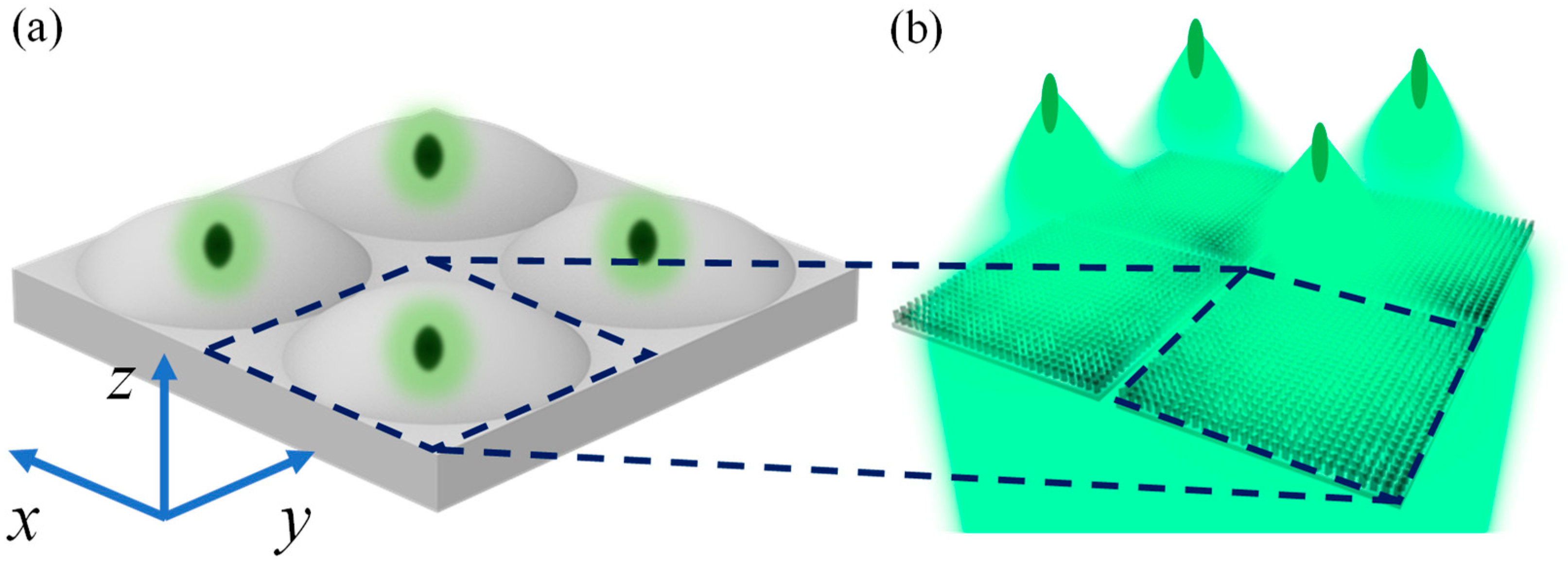
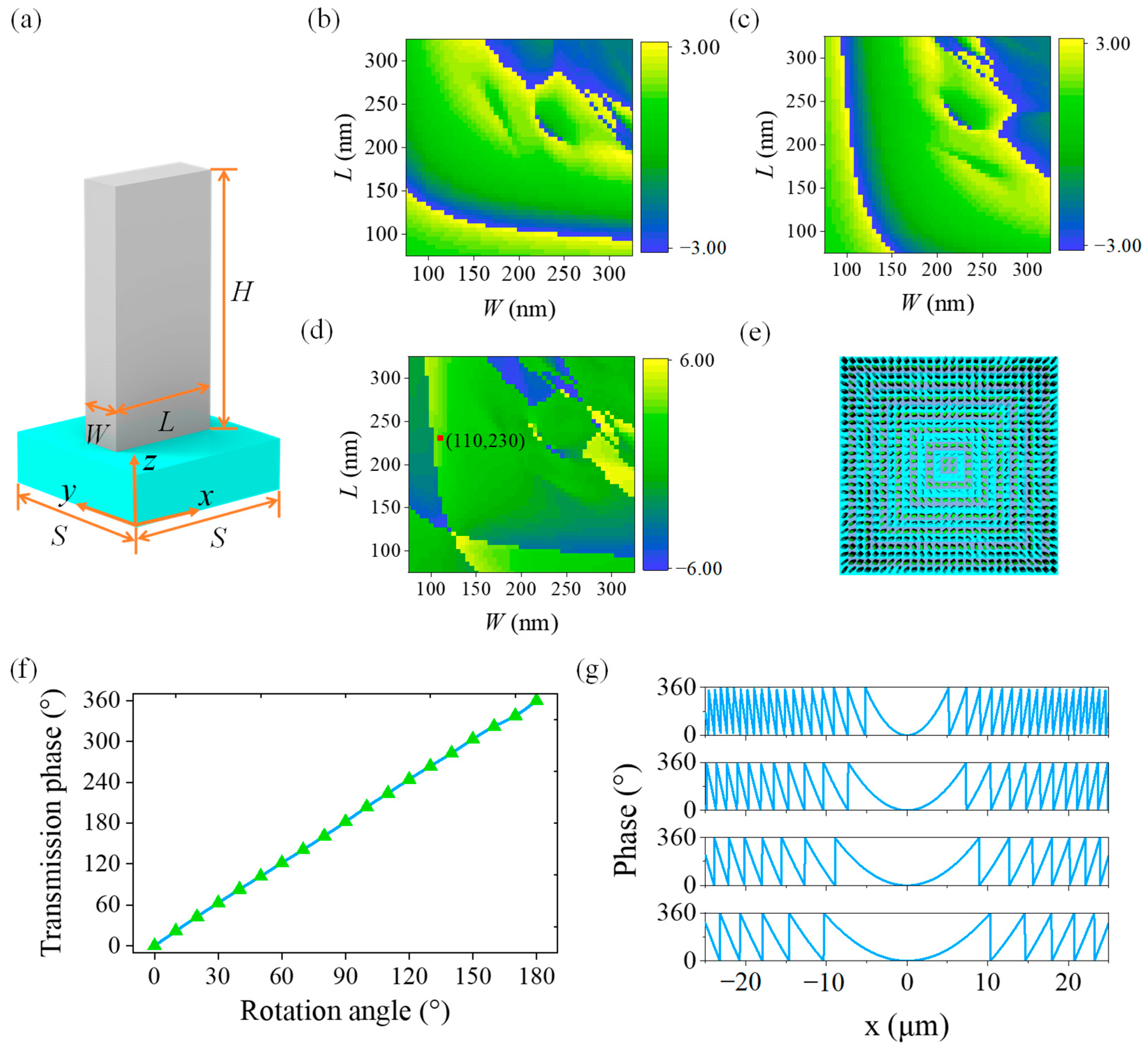
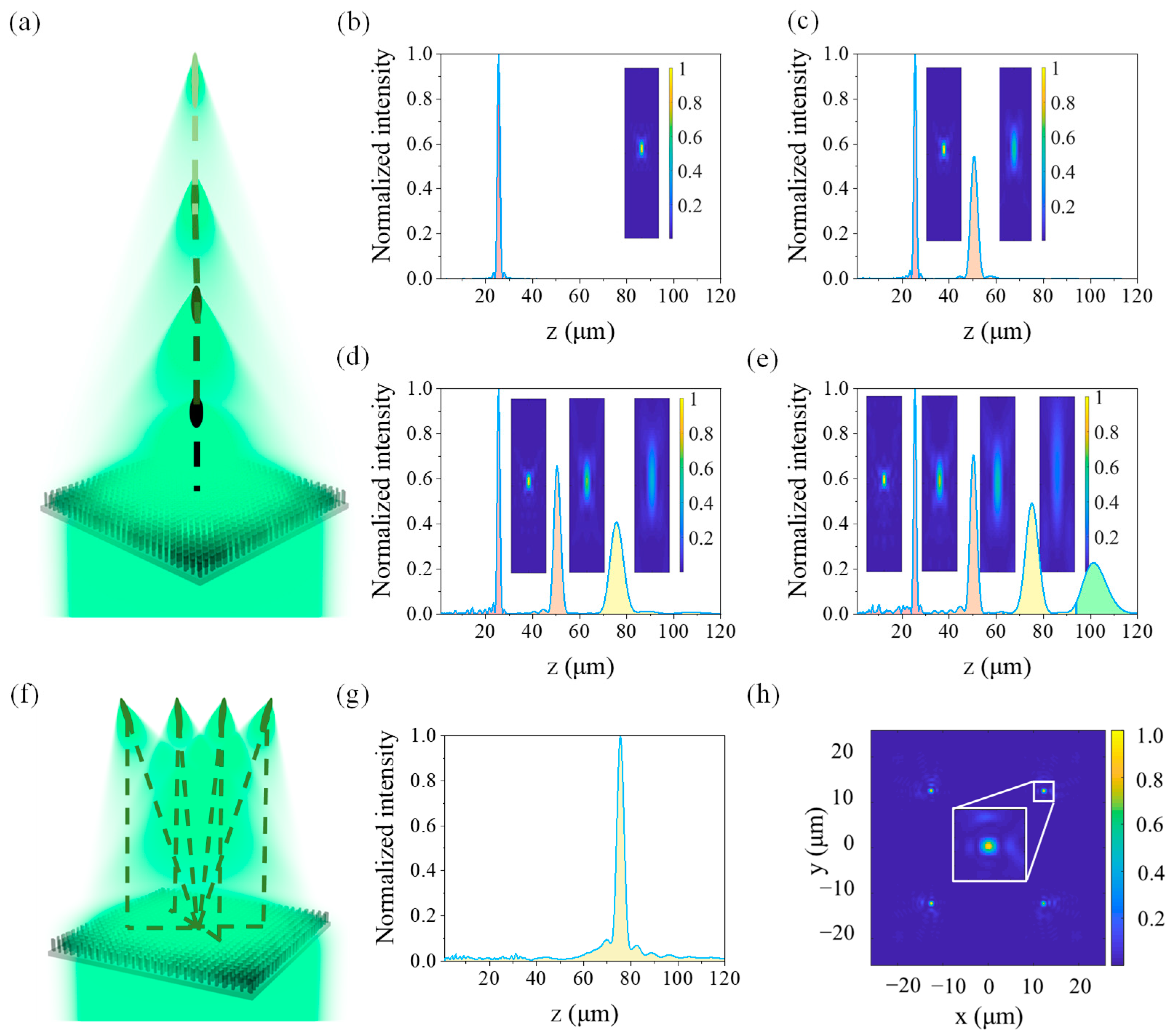
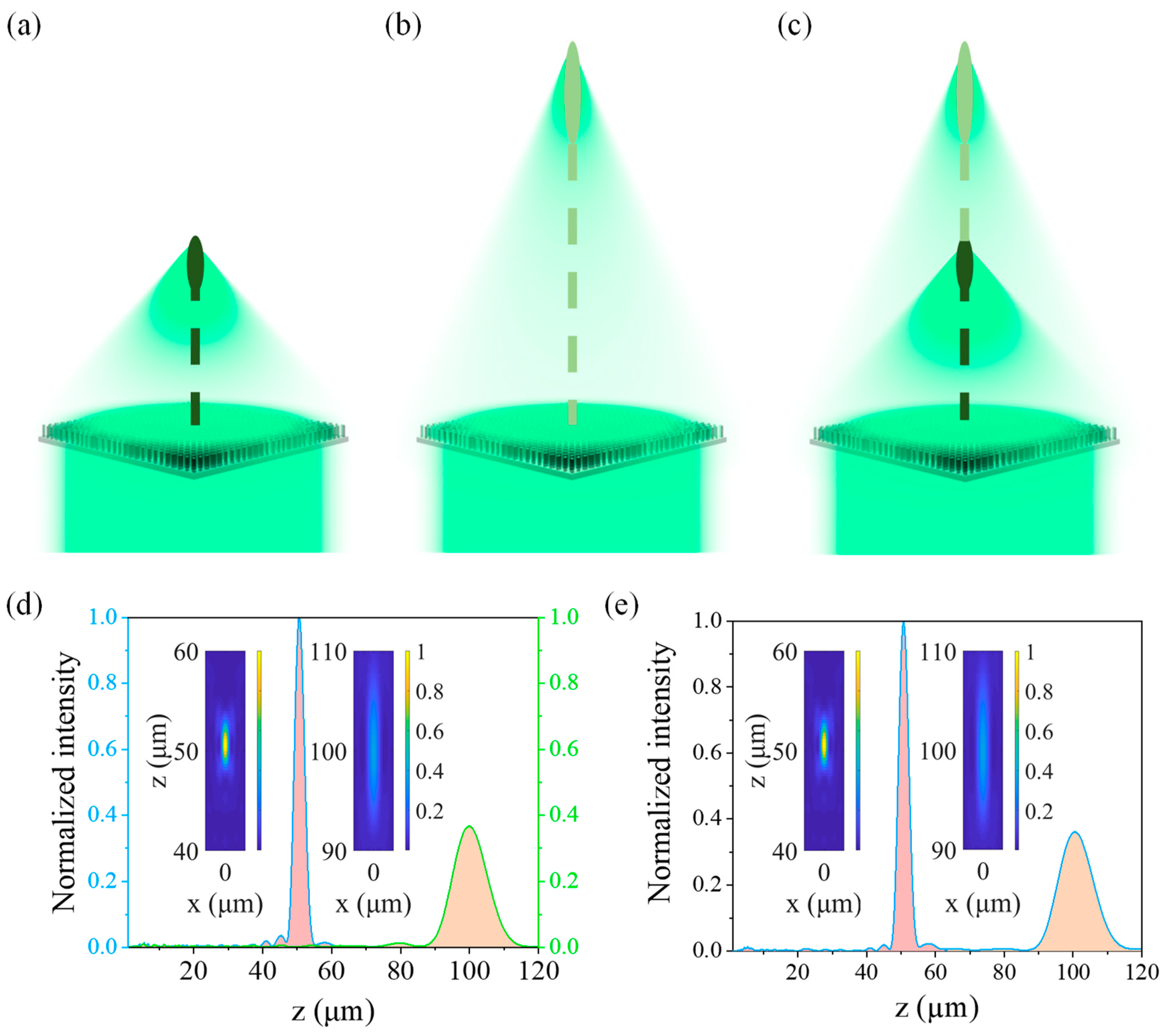
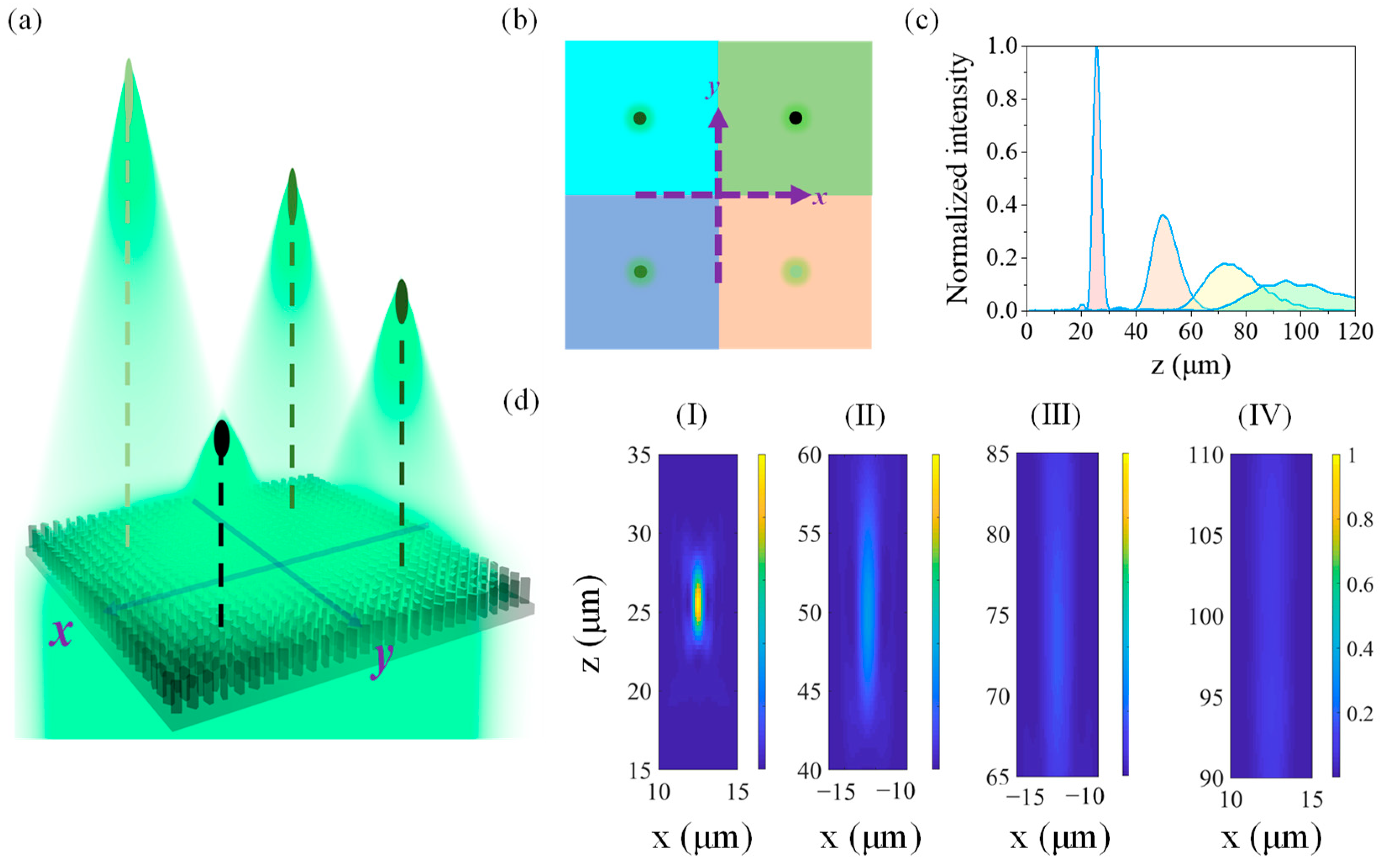
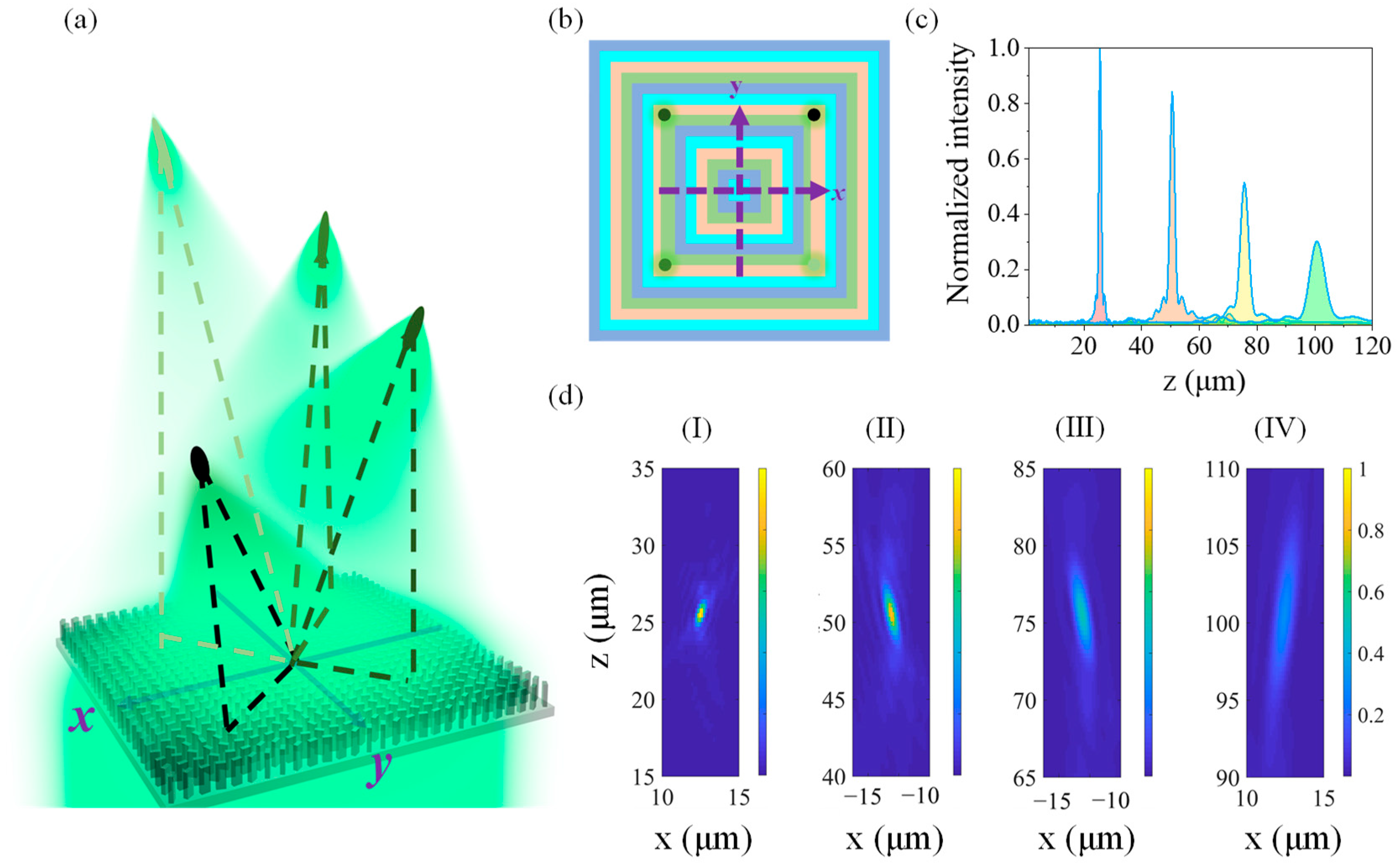
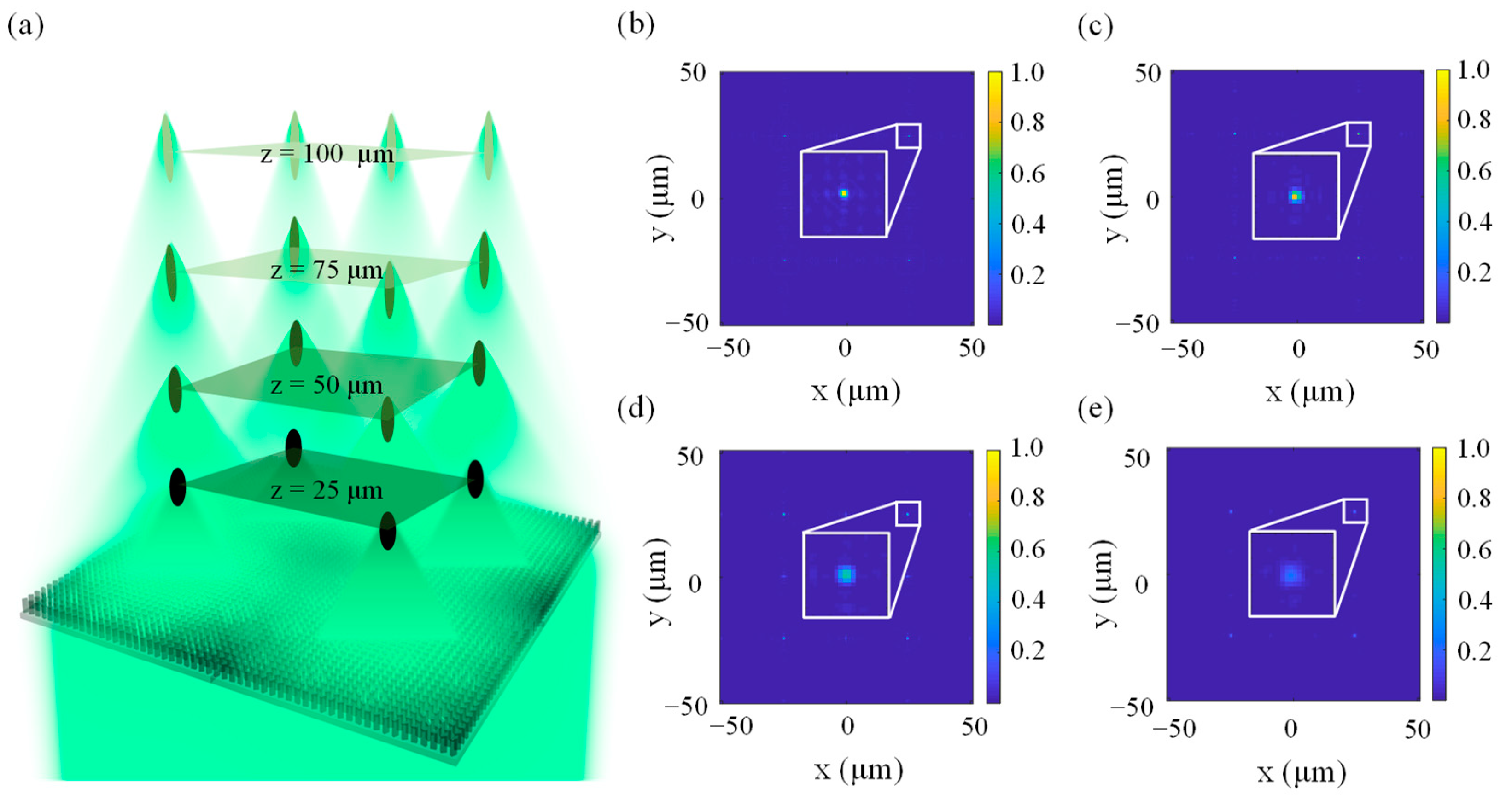
Publisher’s Note: MDPI stays neutral with regard to jurisdictional claims in published maps and institutional affiliations. |
© 2022 by the authors. Licensee MDPI, Basel, Switzerland. This article is an open access article distributed under the terms and conditions of the Creative Commons Attribution (CC BY) license (https://creativecommons.org/licenses/by/4.0/).
Share and Cite
Duan, G.; Zhang, C.; Yang, D.; Wang, Z. Theoretical Design of a Bionic Spatial 3D-Arrayed Multifocal Metalens. Biomimetics 2022, 7, 200. https://doi.org/10.3390/biomimetics7040200
Duan G, Zhang C, Yang D, Wang Z. Theoretical Design of a Bionic Spatial 3D-Arrayed Multifocal Metalens. Biomimetics. 2022; 7(4):200. https://doi.org/10.3390/biomimetics7040200
Chicago/Turabian StyleDuan, Guihui, Ce Zhang, Dongsheng Yang, and Zhaolong Wang. 2022. "Theoretical Design of a Bionic Spatial 3D-Arrayed Multifocal Metalens" Biomimetics 7, no. 4: 200. https://doi.org/10.3390/biomimetics7040200
APA StyleDuan, G., Zhang, C., Yang, D., & Wang, Z. (2022). Theoretical Design of a Bionic Spatial 3D-Arrayed Multifocal Metalens. Biomimetics, 7(4), 200. https://doi.org/10.3390/biomimetics7040200






